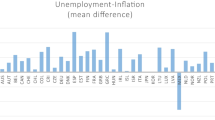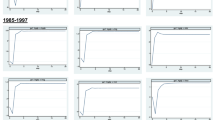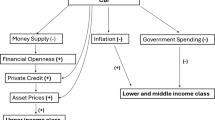Abstract
The debate has been reignited in recent months by both defenders and opponents of the CFA franc, about its benefits or the lack thereof. The objective of this paper is to join the conversation in an objective, and quantifiable way, by investigating the optimality of the currency area. A trivariate SVAR comprising world output, domestic output for each one of the eight countries that make up the West African Economic and Monetary Union (WAEMU), and changes in their price levels, represented by their respective CPIs was estimated. Annual data ranging from 1980 to 2017 was obtained from the IMF 2017 World Outlook. I also investigated endogeneity within the Union, by dividing the data into two samples, one from 1980 to 1993, a period that predates the WAEMU, and one from 1994 to 2017. The results show more synchronization of business cycles during the second period than during the first. I examined the role of trade in the near perfect synchronization of business cycles in the WAEMU, and found it to be the driving force behind the symmetry.
Similar content being viewed by others
References
Bangake, C., and Jude Eggoh. 2009. The Impact of Currency Unions on Trade: Lessons from CFA Franc Zone and Implications for Proposed African Monetary Unions. Savings and Development 33 (1): 61–72.
Blanchard, O., and Danny Quah. 1989. The Dynamic Effects of Aggregate Demand and Supply Disturbances. The American Economic Review 79 (4): 655–673.
Devarajan, S., and Dani Rodrik. 1991. Do the Benefits of Fixed Exchange Rates Outweigh Their Costs? The Franc Zone in Africa. NBER Working Paper 3727.
Frankel, J., and Andrew K. Rose. 1996. The Endogeneity of the Optimal Currency Area Criteria. NBER WP 5700.
Furceri, D., and Georgios Karras. 2008. Business Cycle Synchronization in the EMU. Applied Economics 40 (12): 1491–1501.
Gutner, F. 1999. The CFA Franc Zones and the Theory of Optimal Currency Area. Africa Spectrum 34 (1): 33–57.
Hamilton, James. 1994. Time Series Analysis. Princeton: Princeton University Press.
Horvath, J., and Richard Grabowski. 1997. Prospects of African Integration in Light of the Theory of Optimum Currency Areas. Journal of Economic Integration 12 (1): 1–25.
McKinnon, R. 1963. Optimum Currency Areas. The American Economic Review 53 (4): 717–725.
Mundel, R. 1961. A Theory of Optimal Currency Area. American Economic Review 51 (4): 657–665.
Peersman, G. 2011. The Relative Importance of Symmetric and Asymmetric Shocks: The Case of United Kingdom and Euro Area. Oxford Bulletin of Economics and Statistics 73 (1): 0305–9049.
Rose, A., and Charles Engel. 2002. Currency Unions and International Integration. Journal of Money, Credit and Banking 34 (4): 1067–1089.
Schelkle, W. 2013. Monetary Integration in Crisis: How Well Do Existing Theories Explain the Predicament of EMU? Transfer: European Review of Labor and Research 19: 37–48.
Author information
Authors and Affiliations
Corresponding author
Rights and permissions
About this article
Cite this article
Diagne, M.W. The West African Economic and Monetary Union: Optimality Revisited. J. Quant. Econ. 17, 541–549 (2019). https://doi.org/10.1007/s40953-018-0135-6
Published:
Issue Date:
DOI: https://doi.org/10.1007/s40953-018-0135-6




